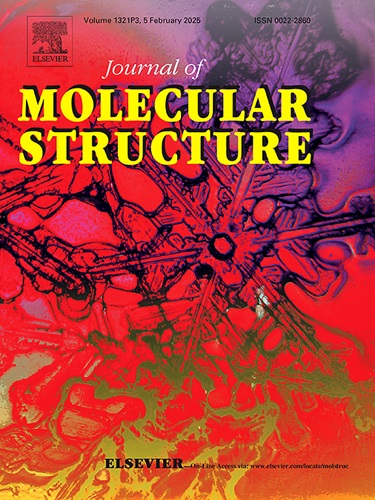Exploring the interaction between ABCL and HAG: a combined experimental and theoretical approach
IF 4
2区 化学
Q2 CHEMISTRY, PHYSICAL
引用次数: 0
Abstract
Abemaciclib (ABCL), as cell cycle-dependent kinase 4/6 inhibitor, is used to treat a variety of tumors, including breast, melanoma, and bladder cancer. The purpose of this paper was to comprehend the binding mechanism of ABCL to the plasma transport protein HAG using multi-spectroscopic approaches, molecular docking, and dynamic simulations. The outcomes revealed that the quenching constant of HAG caused by ABCL declined with the temperature rising, indicating that ABCL could extinguish endogenous fluorescence of HAG through the static quenching method. Thermodynamic analyses, competition experiments, and molecular dynamics simulations indicate that the main driving forces between ABCL and HAG are hydrogen bonding, hydrophobic interactions, and Van der Waals forces. The binding distance between the two was calculated from the FRET theory to be 2.94 nm. Molecular docking showed that ABCL binds within the hydrophobic cavity of HAG. Molecular dynamics simulations confirmed that the original configuration of HAG changed slightly upon incorporation of ABCL. Synchronous fluorescence analysis revealed a hypsochromic shift (∼1 nm) in the maximum emission wavelength of Tyr residues. This blue displacement phenomenon correlates with decreased microenvironmental polarity, likely induced by ABCL binding through two distinct mechanisms, including steric shielding effect and conformational restriction. Far-UV CD spectral results demonstrated subtle conformational perturbations in HAG upon ABCL binding, including α-helix content decreased from 1.84 % to 1.67 % and β-sheet content reduced from 41.92 % to 41.85 %. In addition, some common metal ions, for instance, Cu2+, Mg2+, Fe3+, Ca2+ and Zn2+ may cause the alteration in the binding constant between ABCL and HAG, resulting in changes in the action of ABCL.

探索ABCL与HAG的相互作用:实验与理论相结合的方法
Abemaciclib (ABCL)作为细胞周期依赖性激酶4/6抑制剂,用于治疗多种肿瘤,包括乳腺癌、黑色素瘤和膀胱癌。本文旨在通过多光谱、分子对接、动态模拟等方法了解ABCL与血浆转运蛋白HAG的结合机制。结果表明,ABCL对HAG的猝灭常数随着温度的升高而降低,说明ABCL可以通过静态猝灭的方式对HAG的内源荧光进行猝灭。热力学分析、竞争实验和分子动力学模拟表明,ABCL和HAG之间的主要驱动力是氢键、疏水相互作用和范德华力。根据FRET理论计算出两者之间的结合距离为2.94 nm。分子对接表明,ABCL在HAG的疏水腔内结合。分子动力学模拟证实,在加入ABCL后,HAG的原始结构略有改变。同步荧光分析显示Tyr残基的最大发射波长发生了次色移(~ 1 nm)。这种蓝色位移现象与微环境极性降低有关,可能是由ABCL结合通过两种不同的机制引起的,包括空间屏蔽效应和构象限制。远紫外CD光谱结果显示,ABCL结合后,HAG的构象发生了轻微的扰动,α-螺旋含量从1.84%下降到1.67%,β-薄片含量从41.92%下降到41.85%。此外,一些常见的金属离子,如Cu2+、Mg2+、Fe3+、Ca2+、Zn2+等,都可能引起ABCL与HAG之间结合常数的改变,从而导致ABCL的作用发生变化。
本文章由计算机程序翻译,如有差异,请以英文原文为准。
求助全文
约1分钟内获得全文
求助全文
来源期刊

Journal of Molecular Structure
化学-物理化学
CiteScore
7.10
自引率
15.80%
发文量
2384
审稿时长
45 days
期刊介绍:
The Journal of Molecular Structure is dedicated to the publication of full-length articles and review papers, providing important new structural information on all types of chemical species including:
• Stable and unstable molecules in all types of environments (vapour, molecular beam, liquid, solution, liquid crystal, solid state, matrix-isolated, surface-absorbed etc.)
• Chemical intermediates
• Molecules in excited states
• Biological molecules
• Polymers.
The methods used may include any combination of spectroscopic and non-spectroscopic techniques, for example:
• Infrared spectroscopy (mid, far, near)
• Raman spectroscopy and non-linear Raman methods (CARS, etc.)
• Electronic absorption spectroscopy
• Optical rotatory dispersion and circular dichroism
• Fluorescence and phosphorescence techniques
• Electron spectroscopies (PES, XPS), EXAFS, etc.
• Microwave spectroscopy
• Electron diffraction
• NMR and ESR spectroscopies
• Mössbauer spectroscopy
• X-ray crystallography
• Charge Density Analyses
• Computational Studies (supplementing experimental methods)
We encourage publications combining theoretical and experimental approaches. The structural insights gained by the studies should be correlated with the properties, activity and/ or reactivity of the molecule under investigation and the relevance of this molecule and its implications should be discussed.
 求助内容:
求助内容: 应助结果提醒方式:
应助结果提醒方式:


